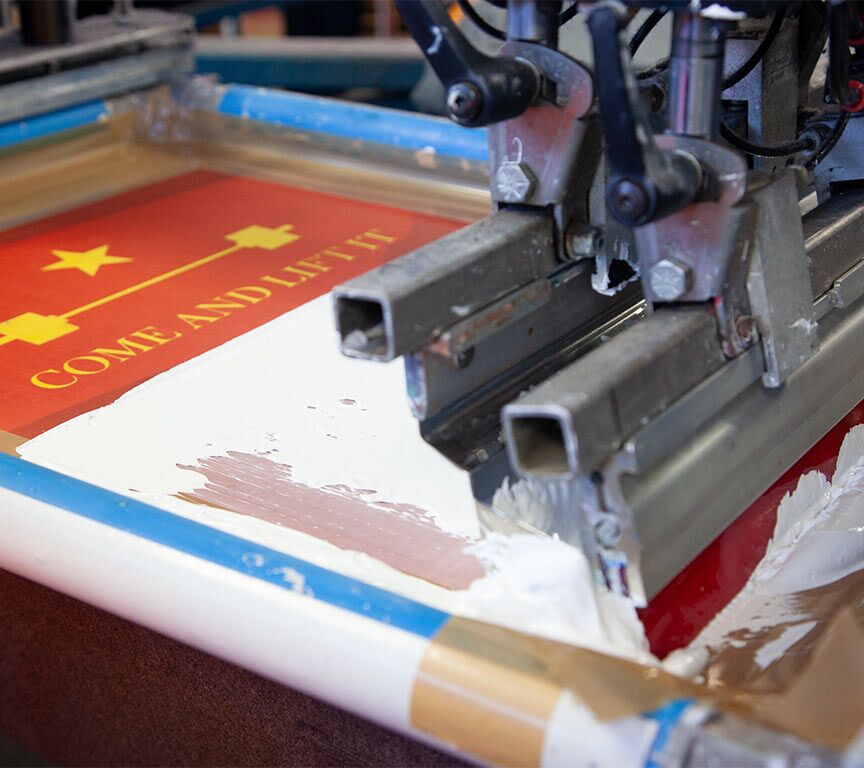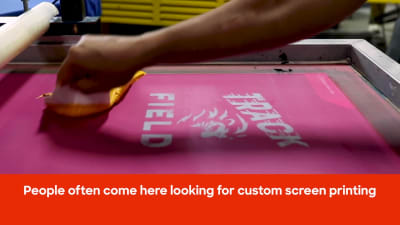Professional Screen Printing Kit for Custom Apparel
Professional Screen Printing Kit for Custom Apparel
Blog Article
Display Printing Uncovered: Whatever You Need to Learn About Tee and Garment Printing Techniques
Display printing is an interesting technique that combines art with method, using unlimited possibilities for creative thinking. All set to discover the essential aspects that make display publishing an art type?
The Basics of Display Printing: Just How It Functions
When you dive right into display printing, you'll discover it's both a science and an art. At its core, screen printing includes producing a pattern, or screen, that permits ink to pass through only in particular locations.
Position the display over the material, after that utilize a squeegee to push ink with the screen onto the garment. Each step is vital, and mastering them will boost your display printing skills, transforming simple garments right into one-of-a-kind, expressive pieces.
Sorts Of Display Printing Techniques
Once you grasp the basics of screen printing, it's time to explore the numerous strategies that can raise your layouts. One popular method is conventional display printing, where ink is pressed via a stenciled screen.
If you're aiming for great information, consider discharge printing. This strategy gets rid of dye from the material, leaving a soft, classic look. One more option is plastisol printing, understood for its sturdiness and vibrant colors, making it a favored for many brand names. Finally, try out halftone printing to develop slope effects and intricate designs. Each strategy has its distinct beauty, so do not be reluctant to attempt them out to discover what fits your style best!
Necessary Equipment for Display Printing
To accomplish spectacular outcomes in screen printing, having the ideal equipment is fundamental. Initially, you'll need a strong display printing structure, which holds the mesh that transfers your layout onto the garment. Next off, buy high-quality squeegees; these are essential for applying ink equally throughout the display. You'll also need an excellent direct exposure unit to produce your screens, along with a washout booth for cleansing them after use. A dependable heat source, like a conveyor clothes dryer or warmth press, is crucial for curing your prints to ensure long life. Don't forget an appropriate work space, geared up with tables and storage for your products. Safety equipment, such as masks and gloves, will keep you risk-free from chemicals and inks. With the right devices, you'll be well on your way to creating professional-quality prints.
Picking the Right Inks and Materials
When selecting inks and products for display printing, you need to take right into account the sort of ink that works finest for your project. Think of textile compatibility to assure your layouts look last and terrific long. Explore environmentally friendly ink options to make your printing process much more sustainable.
Kinds of Screen Inks
Choosing the appropriate display ink is important for achieving vibrant, sturdy prints that fulfill your task's requirements. There are several kinds of screen inks to take a look at. Plastisol ink is prominent for its versatility and convenience of use, offering outstanding shade opacity on dark materials. Water-based ink, on the other hand, provides a softer feel and is environmentally friendly, making it excellent for those aiming to lessen their ecological impact. Release inks remove dye from the textile, leading to a soft, classic look but call for particular handling. Finally, specialty inks, such as glow-in-the-dark or metallic, can add unique impacts to your designs. Review your project requirements and choose the ink that straightens best with your wanted result.

Textile Compatibility Factors To Consider
Comprehending fabric compatibility is important for achieving top notch display prints, particularly since different materials respond uniquely to various inks. When picking inks, take into consideration the textile kind-- cotton, polyester, or blends. For cotton, water-based inks function well, supplying soft qualities and breathability. Polyester, on the various other hand, typically requires plastisol inks for much better bond and vivid shades. If you're publishing on blends, you may need to use a mix of both kinds. Constantly examine your inks on example textile to ensure they adhere properly and keep shade honesty. Furthermore, keep in mind that textile weight and structure can impact the final end result, so choosing the right ink and product combination is important for your project's success.
Eco-Friendly Ink Options
Eco-friendly inks are becoming a preferred choice for display printers that intend to lessen their ecological effect while maintaining top quality. When selecting inks, consider water-based inks, which are less dangerous and much easier to tidy up compared to standard solvents. These inks bond well with fabrics, supplying dynamic outcomes without harmful chemicals. You may likewise explore eco-solvent inks that use less unpredictable natural substances (VOCs), making them a safer alternative for both your health and wellness and the earth.
Furthermore, search for inks made from renewable sources, such as soy or vegetable-based options. By picking the ideal inks and products, you'll not just create sensational designs however also add to a more sustainable printing process. Make the switch, and your prints will official statement reflect your commitment to the setting!
Preparing Your Design for Screen Printing

Submit Format Requirements
To ensure your style looks dynamic and sharp on fabric, you'll need to pay close focus that site to submit format needs for display printing. Make sure your layout has a transparent background to stop undesirable white edges on your prints. Keep shade settings in mind; CMYK is basic for display printing, so convert your RGB designs accordingly.
Shade Separation Techniques
Shade separation is a vital action in preparing your style for display printing, and mastering it can substantially enhance your print high quality. You'll need to break your layout into private shades, as each shade calls for a different screen during printing. Beginning by recognizing all the colors in your style and develop layers for each one. You can use software like Adobe Photoshop or Illustrator to separate and separate colors successfully. Be specific to conserve each layer as a different data, typically in a layout like TIFF or PSD. This precision not only guarantees precise color depiction however also improves the printing process. By paying focus to color separation, you'll attain vibrant and specialist lead to your screen-printed garments.
Resolution and Size
Attaining the most effective cause display printing starts with ensuring your style has the best resolution and dimension. Ideally, your art work should be at least 300 DPI (dots per inch) for sharp, clear prints. If you utilize reduced resolution, your end product could look less than professional and pixelated.
When it pertains to dimension, take into consideration the dimensions of your print location. Design your art work to match the final print dimension, preferably creating it in the actual measurements you'll be publishing. This means, you'll prevent any kind of unexpected scaling concerns.
Constantly check your layout in both vector and raster formats. Vector graphics can be scaled without losing quality, making them optimal for screen printing. Preparing properly will guarantee your design looks remarkable on every garment!
Step-by-Step Display Printing Process
Screen printing is a dynamic procedure that permits you to produce lively layouts on various surface areas. To start, you'll require a display, emulsion, and your chosen ink. review Initially, prepare your screen by cleansing it extensively. Next, apply the solution evenly and let it completely dry in a dark location. Once dry, reveal your display to light with your style placed on it, which will certainly solidify the emulsion where the light hits, developing a stencil - screen printing kit.
After washing out the unexposed solution, your display prepares. Set it up on your printing surface and straighten your garment beneath it. Put ink onto the display and use a squeegee to press the ink via the stencil onto the textile. Lift the screen meticulously and let the print dry. Heal the ink using heat to assure resilience. That's it! You've effectively display published your layout.
Tips for Successful Display Printing Projects
While you're diving right into your screen printing jobs, keep in mind that prep work is vital to success. Beginning by gathering all your materials-- inks, displays, mops, and garments. A clean workspace helps avoid undesirable errors, so clean prior to you start.
Next, confirm your artwork is high-resolution and appropriately sized for your garment. Test your display for appropriate direct exposure and clean it extensively to stay clear of spots. When mixing your inks, comply with the producer's standards to accomplish the right uniformity.
During printing, use even pressure with your squeegee for constant results. Do not hurry; take your time to validate each print fulfills your standards. After printing, allow your garments completely dry totally before managing or packaging them.
Last but not least, constantly keep a sample of your job for future referral. By doing this, you can examine your progression and enhance your strategies in time. Happy printing!

Frequently Asked Inquiries
The length of time Does It Take to Set up a Display Printing Job?
Setting up a display printing work typically takes about half an hour to an hour. You'll prepare the screens, mix inks, and change journalism. The time differs based on intricacy and experience, so remain organized!
Can I Publish on Different Fabric Enters Making Use Of the Exact Same Technique?
Yes, you can print on different material kinds utilizing the exact same method, yet you'll need to readjust your inks and settings. Some materials absorb ink in a different way, so exploring assurances the best results for every product.
What Are Typical Blunders to Stay Clear Of in Display Printing?
When screen printing, stay clear of common blunders like making use of the incorrect ink, disregarding correct exposure times, or skipping pre-press checks. Always check your setup and maintain tidy displays to ensure quality results each time.
Exactly How Can I Appropriately Tidy and Maintain My Screen Printing Devices?
To properly clean and preserve your screen printing equipment, you should routinely wash displays with ideal solvents, examine squeegees for wear, and guarantee all devices are saved dust-free and dry. Consistency prevents expensive repair work and boosts performance.
Is Display Printing Eco Pleasant Compared to Various Other Approaches?
Display printing can be more eco pleasant than various other techniques, especially if you make use of water-based inks and eco-conscious materials. By selecting sustainable supplies and practices, you minimize waste and reduce your effect on the planet.
Screen Printing Uncovered: Whatever You Required to Know Regarding Tee Shirt and Garment Printing Methods
At its core, screen printing includes producing a pattern, or screen, that enables ink to pass with just in specific locations. Setting the screen over the fabric, then make use of a squeegee to push ink through the display onto the garment. One preferred technique is conventional display printing, where ink is pushed via a stenciled screen.When choosing inks and materials for screen printing, you need to take right into account the kind of ink that works ideal for your job.
Report this page